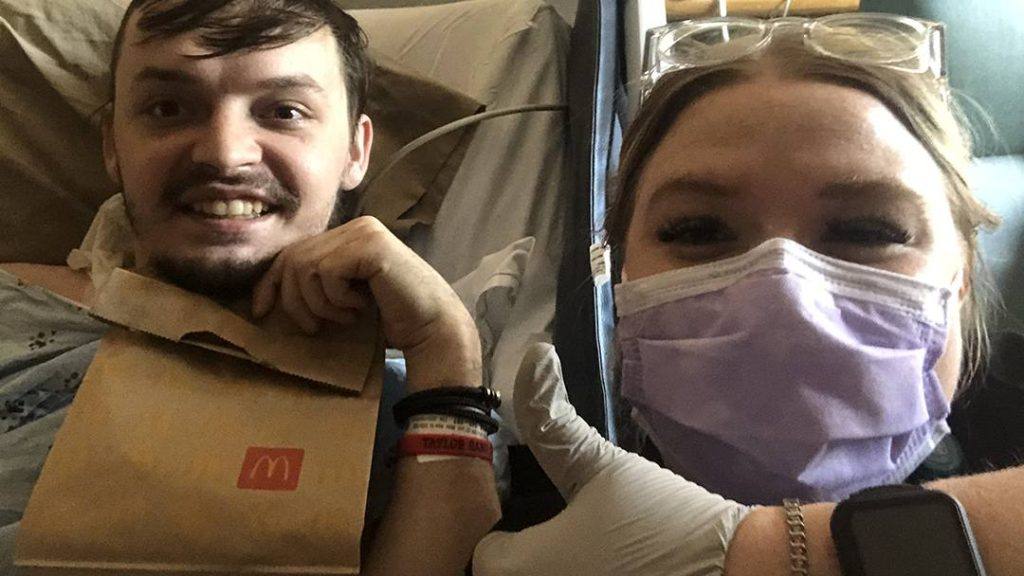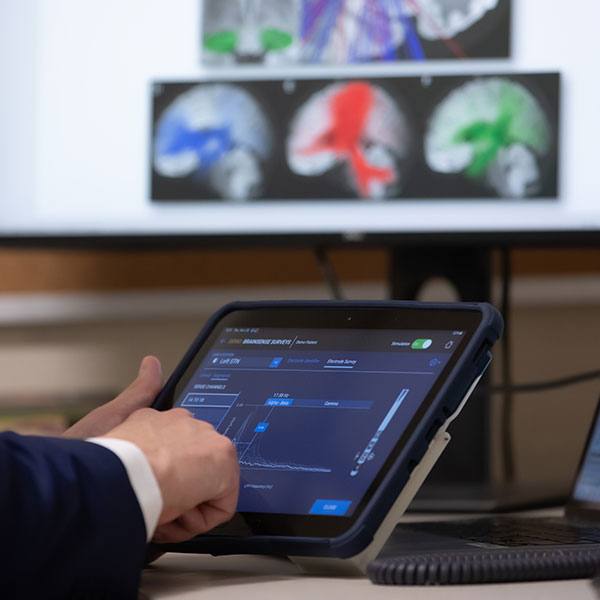
LA CROSSE, Wis. — Taylor Suhr thought he was dying.
"I was terrified," Taylor says. "I woke up, and there were a bunch of tubes coming out of me. I couldn't talk. I panicked."
Taylor wasn't dying. But he'd come close. This past May, Taylor was brought into the emergency room at Mayo Clinic Health System with presumed seizure-like activity. However, the 27-year-old from La Crosse had suffered a major stroke.
"It is extraordinarily rare to see something as catastrophic as this,” said June Chae, M.D., pulmonology and critical care, Mayo Clinic Health System in La Crosse. "There was something off about this patient’s neuro exam and despite his recently normal CT scan of the head, we decided to scan him again. Our radiology tech called us immediately to tell us of the significant interval change in scan findings, so we were able to move fast."
Given his critical neurological condition, acute hydrocephalus, young age, and other issues, neurosurgeon Dr. Navid Khezri decided to proceed with placing an external ventricular drain (EVD).
"The EVD placement comes with risks; however, it was the only option for saving the patient’s life and stabilizing him," says Bridget Servais, stroke coordinator, Mayo Clinic Health System in La Crosse.
"Because of his stroke, the usual pathways in the brain where spinal fluid flows were becoming blocked, leading to a condition called hydrocephalus and brain herniation," explains Dr. Parker Kelley, neurosurgeon, Mayo Clinic Health System in La Crosse. "The increasing pressure of fluid was pushing the brain out of the skull. In order to survive, he would need to have the spinal fluid ‘re-routed’ in a temporary fashion."
Servais says both Dr. Khezri and intensive care physician Dr. Chae met with the family and discussed the critical nature of the situation and the grim prognosis, given the loss of most of his brainstem reflexes.
"At a moment’s notice, the ICU and neurosurgeon teams collaborated and made quick care decisions that ultimately saved this patient’s life,” adds Servais.
Taylor was flown to Mayo Clinic in Rochester where he had surgery to relieve swelling in his brain and was in a coma for close to a week.
Waking to a new reality
In the days after Taylor woke up, he had to adjust to a new reality. He would need to relearn how to do things he had previously given little thought to — things like walking, talking and eating.
"When I first met Taylor he was having significant difficulties even swallowing his own saliva," says Jordan Alvarez, a Mayo Clinic speech pathologist. Communication was a challenge, too. "At first, we used a communication board that had letters and items he could point to."
Alvarez was honest with Taylor. She told him recovery would take time. She also assured him that he’d get better.
"When you're scared and facing a challenge like Taylor's, it's powerful to hear someone say, 'I've seen this before, and it will get better,'" Alvarez says.
For Taylor, getting better started with small steps. He began by swallowing ice chips to start exercising the muscles in his throat.
“We spent about two weeks on ice chips and swallowing exercises,” Alvarez says.
Dreaming about a cheeseburger
But Taylor was eager to move on. He dreamed of eating something real. A cheeseburger topped his list.
"Taylor loves to cook, so eating is very motivating for him," Alvarez says.
About three weeks after Taylor's stroke, a swallow study brought the good news that Taylor was ready to try pureed foods. But the real joy came a week later, when a second swallow study showed that Taylor could eat solid foods chopped into small pieces.
“He was so excited that he cried,” Alvarez says.
Soon Taylor was ready to try foods that were more solid. And Alvarez knew just what his first meal should be.
"I walked over to McDonald's and got him a cheeseburger," she says.
It was a simple meal Taylor will never forget.
“I loved that burger,” he says. “I can still taste it.”
He also has a love for Alvarez and the other staff who cared for him during his recovery.
"Mayo saved my life, " he says. "I shouldn’t be here. This experience made me believe in miracles. "
It's made his mother, a door attendant at Mayo Clinic Health System in Onalaska, Wisconsin, a believer, too.
"I've worked here for 17 years and have always thought Mayo is the best," Cynthia Thorne says. "They proved my faith. They saved my son's life."
"If it weren’t for our bedside nurses noticing a subtle neurologic change, our CT tech and radiologist immediately calling us about the notable change in scan, our neuro intensivists giving guidance from Rochester and our local neurosurgical team coming in to save this patient’s life, we might not be writing this story today. We are so thankful for the outcome,” adds Dr Chae.
Same goes for those who treated Taylor. "It’s incredible to see that the patient is alive and eating cheeseburgers,” exclaims Servais.
For Alvarez, getting to develop relationships with people like Taylor is why she loves her job.
"Taylor had such a great attitude and worked so hard," she says. "People come in at the most challenging time of their lives, and we get to help them get better. It's incredibly rewarding."
About Mayo Clinic Health System
Mayo Clinic Health System consists of clinics, hospitals and other facilities that serve the health care needs of people in Iowa, Minnesota and Wisconsin. The community-based providers, paired with the resources and expertise of Mayo Clinic, enable patients in the region to receive the highest-quality physical and virtual health care close to home.
About Mayo Clinic Health System in La Crosse
In 2022, Mayo Clinic Health System in La Crosse is the only health care facility in Southwest Wisconsin that has received the Centers for Medicare & Medicaid's 5-Star Quality Rating and Leapfrog Grade A for Safety. It was also named one of Newsweek's Best Hospitals in the U.S. and high-performing in five medical conditions and specialties by U.S. News & World Report.
Media contact:
- Rick Thiesse, Mayo Clinic Health System Communications Department
thiesse.ricky@mayo.edu







